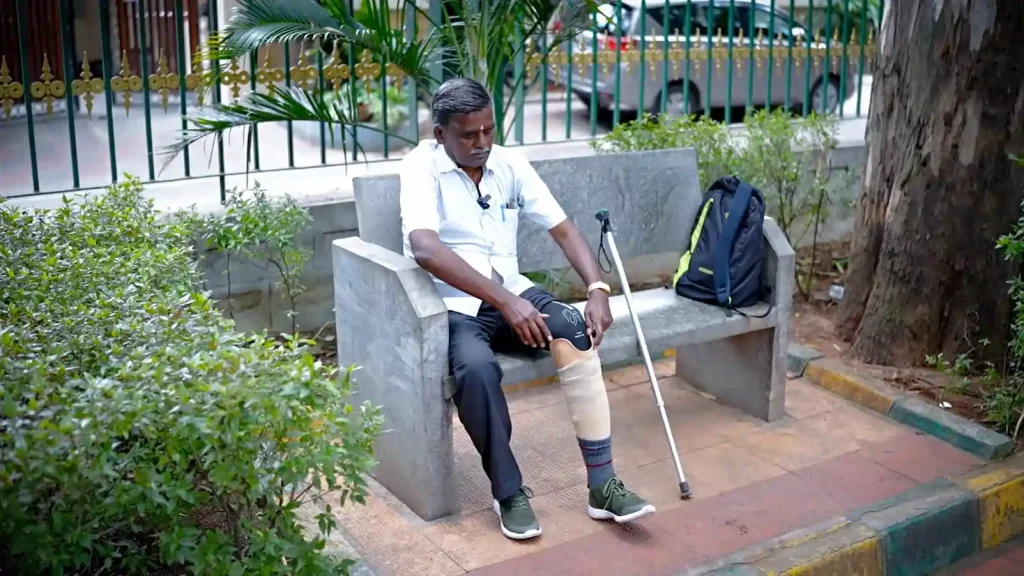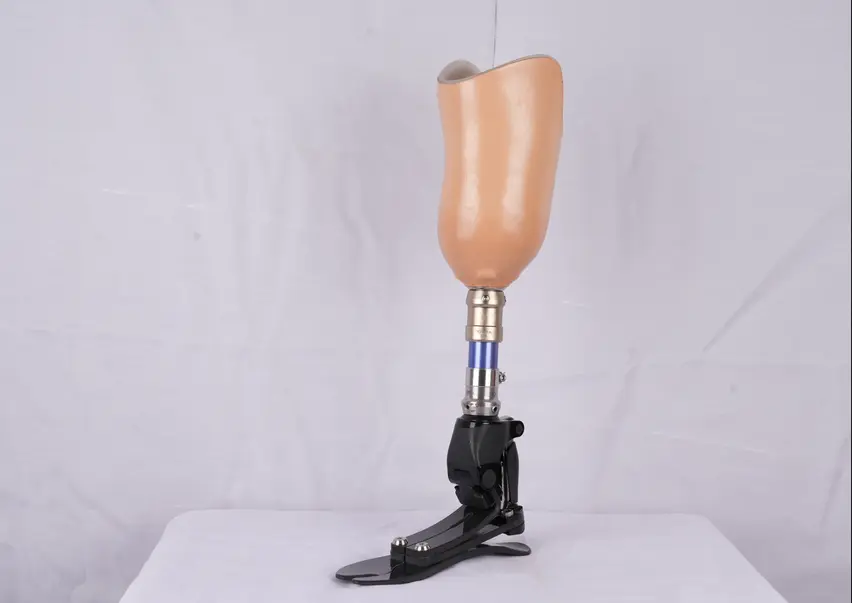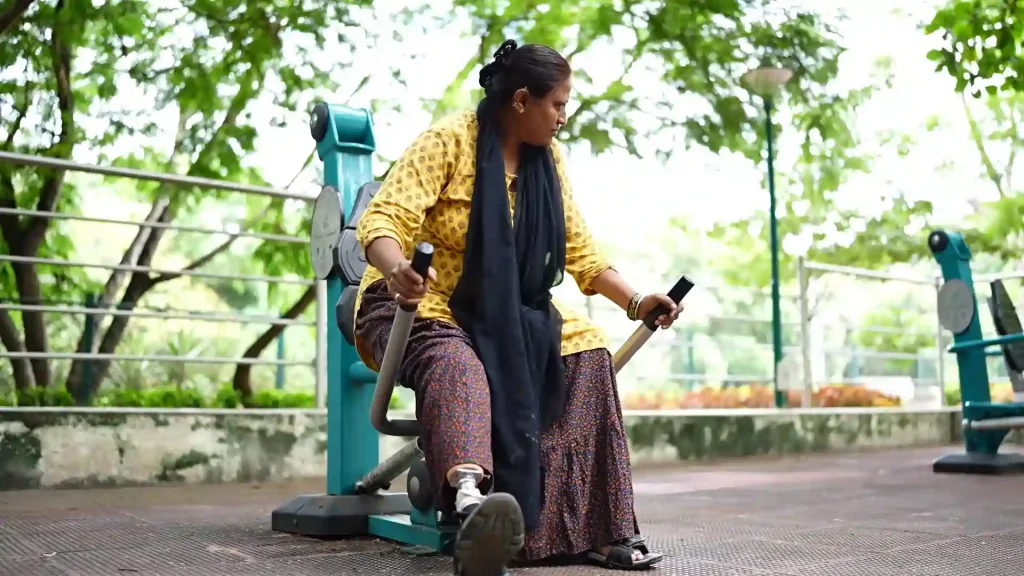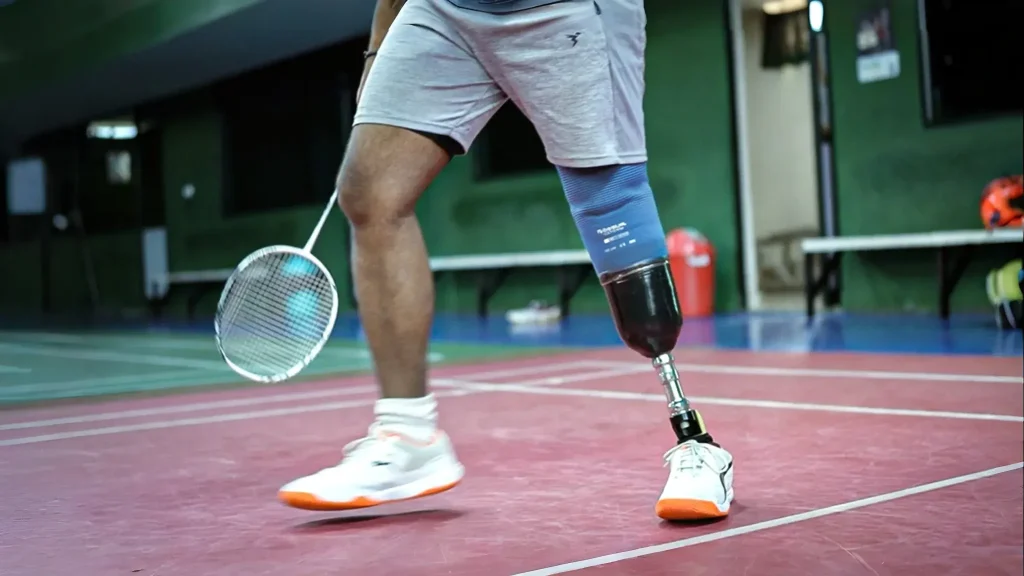Life can take unexpected turns from time to time. For someone who has undergone below-knee amputation, learning with their new condition can be challenging at the start. Recent advancements in prosthetic leg below knee make it possible to improve your walking, movement, and independence.

With detailed information, let’s learn more about the prosthetic legs of the below-knee and their main parts.
Prosthetic Leg Below Knee: What is it?
A prosthetic leg below the knee is an artificial leg that replaces the cut-off leg below the knee joint. It consists of several components, including:
- Socket: The socket connects the remaining part of your leg and the prosthesis. Proper socket fitting is crucial for comfort, stability, and control because it’s custom-made to fit exactly like your limb.
- Pylon: This metal tube is made of lightweight, strong aluminium or carbon fibre, and it supports the artificial foot attached to the socket.
- Foot: A prosthetic foot functions like the normal limb with the added support, shock absorbency, or pedalling power.
What is the Best below the knee Prosthetic Leg?
Deciding on the best below-the-knee prosthetic leg is not as simple as taking one from the shelf. Therefore, instead of saying that a single is “best”, it is more about finding the best for you. It depends on some significant things:
- Your activity level: Are you planning to roam around the house and work? Or are you dreaming of hiking trails, playing games, or dancing at night? The more active you are, the more special and high-tech your prosthetic legs should be.
- Your goal: What do you want to achieve with your artificial leg? Do you want to live with your grandson, be able to return to a specific hobby, or simply feel more stable and safe on your feet? Your goals will significantly affect the type of legs, ankle and socket design that will be most beneficial.
- Your residual leg part: This is part of your foot that remains after dissection. Its size, length, and conditions of the skin and tissues all play an essential role of how a prosthetic socket can be designed for a comfortable and safe fit.
- Component: There is a whole world of prosthetic legs and ankles, each designed for different purposes. Some legs offer significant energy withdrawal for walking, while others are for stability on uneven terrain. Some ankles are fixed, while others are dynamic and may suit different surfaces.
- Relaxation and fit: An artificial leg that causes pain or discomfort is not suitable for use. The socket needs to fit comfortably but not too tightly, without disturbing natural movement or rubbing or pinching.
- Your Prosthetist: Experts assess your requirements, measure, help you choose the correct components, and ensure your prosthetic leg fits and functions correctly.
Therefore, focus on having an open interaction with your prosthetist, your lifestyle, goals and what makes you feel comfortable.
What are the different types of prosthetic leg below the knee?
Various prosthetic feet are available to meet the different needs of people with lower limb requirements.
1. Hydraulic Ankle Feet
Hydraulic ankle feet offer more stability, enable walking across various terrains and surfaces, and reduce socket pressure points.
2. SACH (Solid Ankle Cushioned Heel) Foot:
This foot design has a solid ankle and heel with cushions to absorb shock impact. SACH feet are lightweight prosthetics suitable for light activity. Therefore, they are best suited for individuals with lower activity levels, such as slow walkers.
3. Powered Feet
Powered feet are battery-operated and can automate the action of the calf and foot muscles. They are also heavy and need to be recharged every day. Still, select patients have reported reduced fatigue with this technology. They store energy during the ground-contact phase of walking and return it during push-off, resulting in a more natural gait and lower energy consumption. These are great for people who like extended walks or light hiking.
4. Axial Feet
Single-axial feet simulate the articulation of the ankle joint in that they can articulate at a mechanical ankle joint. They add stability and are usually the preferred choice for more. Multi-axial feet increase the stability and comfort of the foot on non-level surfaces.
5. Dynamic Response Feet
Dynamic response feet are made to tolerate very high-impact activities and are incredibly flexible and responsive, allowing for jogging or sports. They have lightweight materials, advanced flexibility, and a design to maximise energy return.
6. Microprocessor-Controlled Feet and Ankles
These are complex devices with sensors to control and adjust the position of the ankle and foot, depending on walking speed, terrain, and incline. These devices provide a more natural and efficient gait, more stability, and require less effort on unstable surfaces.
Can We Walk Normally with An Artificial Leg Below Knee?
Yes, a below-knee prosthetic leg enables people to walk again. However, before the patient becomes fully active, there is considerable rehabilitation and physical therapy that include:
- Strengthening the residual limb and muscles.
- Improving balance and coordination.
- Practising putting on and taking off the prosthetic leg correctly.
- Working from standing and weight-bearing to walking with walkers or canes to independent walking.
The efficiency of the artificial leg is based on the socket’s fit and the components’ alignment. Therefore, an experienced rehabilitation team can help to achieve mobility, independence, and the ability to do everyday activities.
Prosthetic Leg Below Knee for Running Activity: What To Know
Many people wish to have an active lifestyle, and the question about running with a prosthesis comes up, and it is a pretty important one. Prosthetic feet designed for running contain unique shapes and materials for the propulsion and shock absorption required for activities. So, to facilitate running ability, you must utilise the right equipment.
When talking about running feet for prosthetics, there are specific kinds of running feet:
- Sprinting feet: Sprint runners tend to need foot prosthetics that are stiffer compared to prosthetics intended for longer-distance running, faster energy return and proper push-off for the runner.
- Long-distance running feet: The C-shaped curves enable the user to achieve long-distance running. The curve of the long-distance running foot releases energy at a slower rate, unlike the foot shaped like a “J” that releases energy in a quick burst for sprint runners.
- Limb length disagreement: Artificial feet designed for running are very good at returning energy because they compress and spring back when you run. However, the sides of these feet can become relatively narrow. To help the runner maintain better balance, the person who makes the artificial leg often makes the running leg slightly longer.
- Foot whip: Foot whip is an inward foot rotation that occurs when running, especially when someone has weak hips. Prosthetic running feet limit foot whip.
Provided:
- A stable, well-fitting prosthesis.
- A running-specific prosthetic foot.
- Specific training and conditioning to build strength, endurance, and develop running skills.
- Consultation from physical therapists and possibly running coaches with experience working with amputees.
Interested in exploring running-specific prosthetics? Contact the experts at KARE Prosthetics & Orthotics to discuss your athletic goals.
Best Prosthetic leg below the knee in India: Why Choose KARE Prosthetics & Orthotics?
- Best Quality: You can choose from international quality prostheses with high-quality materials.
- Tie-ups with international Brands: KARE collaborates with global brands like OSSUR, ORTHOMERICA and others to provide innovative products to their patients.
- Affordability: KARE provides cost-effective solutions like the SACH foot when needed.
- Consultation: They offer the best consultation, listen to you, and design a plan that suits your needs.
- Rehabilitation: They provide the prosthetic limb with rehabilitation support.
To get the best prosthetic leg below-knee cost in India, contact Kare Prosthetics & Orthotics
What are the Best Prosthetic Legs for Below Knee?

Prosthetic Legs below the knee are available in various types to suit the user’s health conditions and activity level. Here are some top categories offered by KARE Prosthetics & Orthotics:
1. Base-level SACH
The SACH (Solid Ankle Cushion Heel) foot is an affordable, stable foot suitable for low-activity levels. It offers:
- A non-articulated foot with a non-flexible keel.
- The inner rubber is compressed under load, creating toe-off and heel strike movement.
- It is lightweight and fixed with one bolt.
- The SACH foot can serve both Transfemoral and Transtibial amputation levels.
2. Breeze Foot
This K2 prosthetic foot stands out for its advanced technology, affordable cost and superior features:
- Intelliweave composite: This is a 3d woven material that provides gait matching and durability. Balance and flexibility
- Antimicrobial shell: Preventing bacteria, fungi, and other microorganisms
- UV protection: Protects from harmful ultraviolet sun rays.
- Integrated pyramid: This connects the socket, foot, and joints, and fine-tunes the alignment in various planes to optimise function and comfort
3. Aspire Foot
The Aspire foot is universally usable, offering a dynamic heel, smooth roll-over, and a sandal toe for use with a wide range of footwear. Its customised construction optimises walking efficiency and reduces fatigue for the user. It has a visual appeal.
Features include :
- Carbon-X Active Heel
- Proportional response
- Active energy return
- Split Toe
4. BioStep LP
This prosthetic leg has a low build height, offering great freedom. It is an ideal solution for active users with long residual limbs. It reduces any secondary issues and supports an active lifestyle.
- Responsive with low height
- Lightweight features
- Energy-efficient gait
- Smooth rollover
- Ground compliance and stability
- Balanced posture and symmetrical gait
5. The Pro-Flex LP Align
This OSSUR product is compatible with most footwear; users must not sacrifice alignment, posture, dynamics, or functionality. It suits mobility classes 2 and 3.
Features:
- Split Toe Design: Provides natural-like foot movement, improves mobility and comfort.
- Customisable Heel Height: The user can adjust the heel height to match the different types of shoes they wear.
- Adjustable Alignment: This allows seamless movement and lower leg alignment.
- Adaptable: It is adjustable to suit activities, providing balance
- Open-Toe Design: Made to fit with open-toe sandals.
6. Pro-Flex XC
The Ossur Pro-Flex XC, an OSSUR product, offers comfort and is suitable for outdoor activities such as hiking, jogging, and walking. However, it is relatively expensive.
Features:
- Active Tibial progression
- Carbon-X Active heel
- Full-length toe lever
- Split toe/ sandal toe
- Proportional response and closely mimics the natural foot
7. Pro-Flex Pivot
The OSSUR Pro-flex Pivot foot provides greater ankle power than other feet. It enhances protection, enables natural movement, and has an excellent range of ankle motion. It provides smooth, comfortable, and seamless adaptation to your daily needs.
It is a lightweight foot cover with a grippy sole that stabilises barefoot. It is easy to clean and suitable for various footwear.
- Good energy return
- Helps reduce load
- It resembles regular biomechanics
- 27 degrees of ankle movement
8. Pro-Flex LP
The OSSUR Pro-flex LP foot, is best for users with longer limbs as it has a low profile height. It offers greater comfort for various activities, less load, and more dynamics. The foot has all the features of the Pro-flex XC foot.
Features:
- Full-length toe lever
- Active Tibial Progression
- Proportional response
- Weatherproof
9. Rush LP
This quality prosthetic is suitable for activity levels K2-K3. It comes with a suspension fitted with a base or a shuttle lock and a carbon-laminated socket. It is an expensive but quality option.
The Rush LP is ideal for amputees who have lengthy residual limbs.
Features:
- Smooth roll-over
- High energy return
- Suitable for all terrains
- Waterproof
9. Rush Hi-Pro
The PROTEOR RUSH Hi-Pro combines the benefits of RUSH feet to provide high energy return and enable users to cover rough terrain easily. However, it is an expensive option.
Features:
- Smooth roll-over
- High energy return
- Glass composite material
- Suitable for all terrains
- Waterproof
- Rotatable and non-rotatable male and female proximal adapters
Prosthetic Leg Below Knee Exercises
Rehabilitation and various exercises are crucial for people with prosthetic legs below the knee. These exercises are of two types:
- Pre-prosthetic exercises: Physical training makes the body fit for the prosthesis. It includes strengthening the various muscles and improving hip and knee movement. Consequently, the exercises balance the upper body and core, making them transferable. Stretching, bridging exercises, and seated balance drills are used at this stage.
- Post-prosthetic exercise: After the prosthesis is fitted, the exercises include balance training for standing and walking, efficient movement, muscle strengthening for movement and functional activities.
For comprehensive support and guidance throughout your rehabilitation journey, contact the experienced team at KARE Prosthetics & Orthotics.
What are the Factors Affecting the Prosthetic Leg Below Knee Price?
Many people are concerned about the financial aspect. Prices depend on:
- Type of prosthetic legs and ankle components: Basic SACH legs will be cheaper than advanced energy-storing or microprocessor-controlled options. Socket designs and materials: Custom-moulded sockets with advanced liners can cost more than affordable simple designs.
- Suspension system: Different ways of attaching prostheses such as pin lock, suction, and elevated vacuum, have different costs.
- Complexity of the fitting process: More complex prosthetic legs requiring multiple adjustments will cost more.
- Prosthetist fees: The cost of professional services may vary between clinics. The price includes the clinic fees, materials used, technology levels, and whether the component is domestic or imported.
Conclusion
Living a productive life with a prosthetic leg below the knee has various challenges. However, considerable functionality and mobility are possible with highly improved prosthetic legs. Therefore, after reading this blog, you must have a basic idea about the various options of artificial legs below knee, the rehabilitation process, and the cost.
Therefore, you should select the artificial leg that meets your needs and goals, and have a detailed discussion with a qualified prosthetist and rehabilitation team.

For more details, consider contacting KARE Prosthetics & Orthotics.
Frequently Asked Questions
Learning to walk with a below-knee prosthetic leg is different for everyone, but most people start walking within a few weeks to a couple of months after getting their prosthesis.
Here’s a simple breakdown:
First few days: You’ll begin by learning how to put on and take off the prosthetic leg and get used to standing with it.
2 to 6 weeks: With the help of a physiotherapist, you’ll start walking slowly, build strength and balance, and learn proper walking patterns.
After 2 to 3 months: Most people are able to walk more confidently and start doing regular daily activities.
That said, recovery time depends on your overall health, motivation, the fit of the prosthesis, and how consistently you do physiotherapy. Some people adjust faster, while others may take longer, and that’s completely okay.
At KARE Prosthetics & Orthotics, we guide you through every step — from fitting your prosthesis to helping you walk with confidence again.
A socket grips the remaining part of the limb, while the pylon is the lower leg bone that supports the artificial leg. It resembles a metal tube and can be covered with a cosmetic cover.
You must call the prosthetist if you are feeling discomfort, noticing bruising or sores, or hearing strange sounds from the prosthesis.
Yes, you can run with a prosthetic leg, provided it is suitable for a high activity level.





